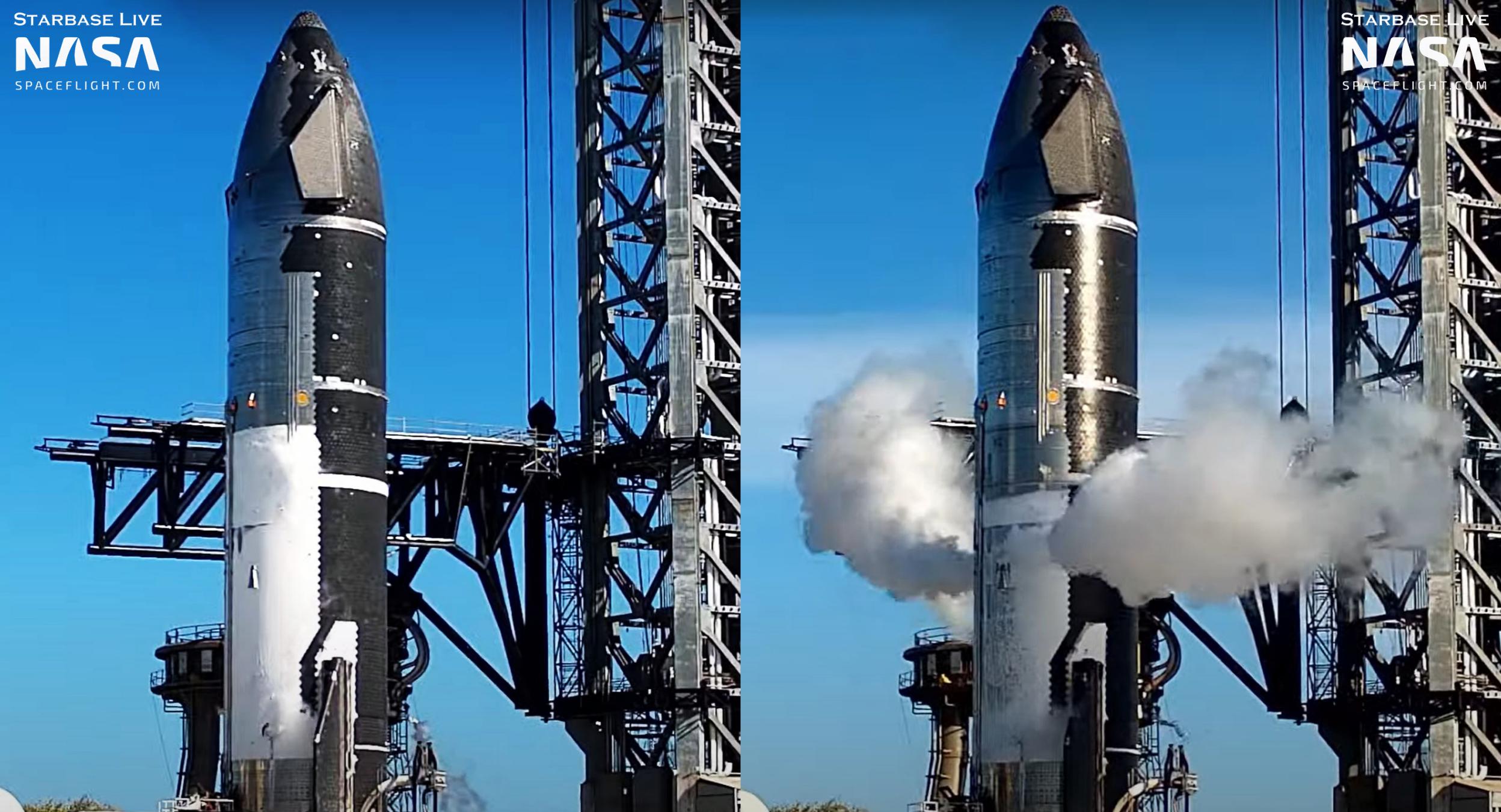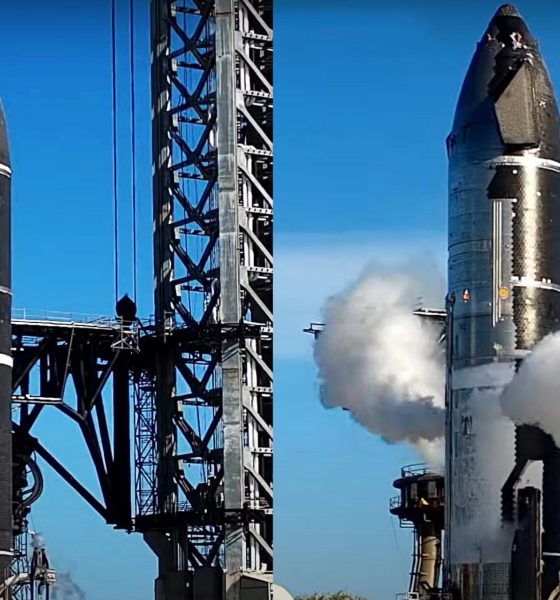

News
SpaceX’s upgraded Starship passes first ‘cryoproof’ test after repairs
SpaceX CEO Elon Musk says an upgraded Starship prototype has passed its first cryogenic proof or ‘cryoproof’ test after undergoing a week of repairs.
Around noon, local sheriffs closed the road to Starbase’s orbital launch site (OLS) and SpaceX cleared the pad of all personnel, freeing up Starship S24 for the next stage of testing. A week prior, on May 27th, Ship 24 suffered some degree of internal damage during a simpler pneumatic proof test with ambient-temperature nitrogen gas. It’s now clear that most of that pneumatic proof test was successful, demonstrating that the Starship’s main propellant tanks and associated plumbing and valves were structurally sound and working as expected.
Still, for about a week after that first test, teams of SpaceX workers swarmed the Starship prototype 24/7 and were seen extracting damaged plumbing and carefully transporting replacement parts inside. Only on the morning of June 2nd was Ship 24 sealed up again.
Cryogenic fluid loading – liquid nitrogen or a combo of LN2 and liquid oxygen (LOx) – began shortly before 3pm CDT (UTC-5) and the Starship’s main tanks were fully filled about 70 minutes later. SpaceX then let those fluids naturally warm, causing a small portion to boil into gas and gradually raise the pressure inside Ship 24’s main tanks. As the pressure grew, sections of the layers of frost and ice that formed on the outside of its thin steel tanks occasionally sloughed off in sheets or broke off in fragments – the only evidence of stress aside from venting.
After about an hour fully filled, SpaceX began detanking and depressurizing Ship 24. The road and pad were reopened around 8:40 pm. All told, aside from an apparent leak on its liquid oxygen tank access hatch, a very common occurrence, Ship 24 exhibited no unusual behavior and made it through its first cryoproof without any obvious issue. More importantly, SpaceX did not appear to reattempt the pneumatic proof test the ship partially failed before the harder cryoproof test, implying that its first test was mostly successful. CEO Elon Musk later confirmed that the Starship had passed its first cryoproof test a few hours after.
Despite Musk’s positive comment, there was no evidence of activity in Ship 24’s nose section, where a number of crucial vents and secondary header tanks – meant to serve as attitude control thrusters and store landing propellant – are located. Ship 24 is the first Starship prototype with a new design that moved both header tanks into the tip of the nosecone. The nose itself is also the first with a number of other manufacturing and design upgrades to reach a test stand, so verifying that it works as expected is doubly important.
Given that the plumbing that failed in the first test may have been connected to Ship 24’s nose section and header tanks and that neither was obviously involved in the subsequent June 2nd cryoproof, it’s likely that the Starship prototype is not done with cryoproof testing just yet. Nonetheless, the ship’s survival and passage of its first cryoproof bodes well for the next steps.
In the near future, SpaceX is expected to move Ship 24 to a nearby ‘suborbital pad’ and test stand that has been significantly modified to simulate the thrust and mechanical stress of six Raptor 2 engines. If or when Ship 24 passes that test or tests, SpaceX will likely remove the stand’s hydraulic rams and begin installing Raptor engines and associated heat shielding. Then, Starship S24 can enter the final stages of qualification: wet dress rehearsal and static fire testing.
SpaceX has requested additional road closures for potential testing on June 6th, 7th, and 8th.

News
Tesla (TSLA) receives “Buy” rating and $551 PT from Canaccord Genuity
He also maintained a “Buy” rating for TSLA stock over the company’s improving long-term outlook, which is driven by autonomy and robotics.

Canaccord Genuity analyst George Gianarikas raised his Tesla (NASDAQ:TSLA) price target from $482 to $551. He also maintained a “Buy” rating for TSLA stock over the company’s improving long-term outlook, which is driven by autonomy and robotics.
The analyst’s updated note
Gianarikas lowered his 4Q25 delivery estimates but pointed to several positive factors in the Tesla story. He noted that EV adoption in emerging markets is gaining pace, and progress in FSD and the Robotaxi rollout in 2026 represent major upside drivers. Further progress in the Optimus program next year could also add more momentum for the electric vehicle maker.
“Overall, yes, 4Q25 delivery expectations are being revised lower. However, the reset in the US EV market is laying the groundwork for a more durable and attractive long-term demand environment.
“At the same time, EV penetration in emerging markets is accelerating, reinforcing Tesla’s potential multi‑year growth runway beyond the US. Global progress in FSD and the anticipated rollout of a larger robotaxi fleet in 2026 are increasingly important components of the Tesla equity story and could provide sentiment tailwinds,” the analyst wrote.
Tesla’s busy 2026
The upcoming year would be a busy one for Tesla, considering the company’s plans and targets. The autonomous two-seat Cybercab has been confirmed to start production sometime in Q2 2026, as per Elon Musk during the 2025 Annual Shareholder Meeting.
Apart from this, Tesla is also expected to unveil the next-generation Roadster on April 1, 2026. Tesla is also expected to start high-volume production of the Tesla Semi in Nevada next year.
Apart from vehicle launches, Tesla has expressed its intentions to significantly ramp the rollout of FSD to several regions worldwide, such as Europe. Plans are also underway to launch more Robotaxi networks in several more key areas across the United States.
News
Waymo sues Santa Monica over order to halt overnight charging sessions
In its complaint, Waymo argued that its self-driving cars’ operations do not constitute a public nuisance, and compliance with the city’s order would cause the company irreparable harm.

Waymo has filed a lawsuit against the City of Santa Monica in Los Angeles County Superior Court, seeking to block an order that requires the company to cease overnight charging at two facilities.
In its complaint, Waymo argued that its self-driving cars’ operations do not constitute a public nuisance, and compliance with the city’s order would cause the company irreparable harm.
Nuisance claims
As noted in a report from the Los Angeles Times, Waymo’s two charging sites at Euclid Street and Broadway have operated for about a year, supporting the company’s growing fleet with round-the-clock activity. Unfortunately, this has also resulted in residents in the area reportedly being unable to sleep due to incessant beeping from self-driving taxis that are moving in and out of the charging stations around the clock.
Frustrated residents have protested against the Waymos by blocking the vehicles’ paths, placing cones, and “stacking” cars to create backups. This has also resulted in multiple calls to the police.
Last month, the city issued an order to Waymo and its charging partner, Voltera, to cease overnight operations at the charging locations, stating that the self-driving vehicles’ activities at night were a public nuisance. A December 15 meeting yielded no agreement on mitigations like software rerouting. Waymo proposed changes, but the city reportedly insisted that nothing would satisfy the irate residents.
“We are disappointed that the City has chosen an adversarial path over a collaborative one. The City’s position has been to insist that no actions taken or proposed by Waymo would satisfy the complaining neighbors and therefore must be deemed insufficient,” a Waymo spokesperson stated.
Waymo pushes back
In its legal complaint, Waymo stated that its “activities at the Broadway Facilities do not constitute a public nuisance.” The company also noted that it “faces imminent and irreparable harm to its operations, employees, and customers” from the city’s order. The suit also stated that the city was fully aware that the Voltera charging sites would be operating around the clock to support Waymo’s self-driving taxis.
The company highlighted over one million trips in Santa Monica since launch, with more than 50,000 rides starting or ending there in November alone. Waymo also criticized the city for adopting a contentious strategy against businesses.
“The City of Santa Monica’s recent actions are inconsistent with its stated goal of attracting investment. At a time when the City faces a serious fiscal crisis, officials are choosing to obstruct properly permitted investment rather than fostering a ‘ready for business’ environment,” Waymo stated.
News
Tesla FSD v14.2.2 is getting rave reviews from drivers
So far, early testers have reported buttery-smooth drives with confident performance, even at night or on twisty roads.

Tesla Full Self-Driving (Supervised) v14.2.2 is receiving positive reviews from owners, with several drivers praising the build’s lack of hesitation during lane changes and its smoother decision-making, among others.
The update, which started rolling out on Monday, also adds features like dynamic arrival pin adjustment. So far, early testers have reported buttery-smooth drives with confident performance, even at night or on twisty roads.
Owners highlight major improvements
Longtime Tesla owner and FSD user @BLKMDL3 shared a detailed 10-hour impression of FSD v14.2.2, noting that the system exhibited “zero lane change hesitation” and “extremely refined” lane choices. He praised Mad Max mode’s performance, stellar parking in locations including ticket dispensers, and impressive canyon runs even in dark conditions.
Fellow FSD user Dan Burkland reported an hour of FSD v14.2.2’s nighttime driving with “zero hesitations” and “buttery smooth” confidence reminiscent of Robotaxi rides in areas such as Austin, Texas. Veteran FSD user Whole Mars Catalog also demonstrated voice navigation via Grok, while Tesla owner Devin Olsen completed a nearly two-hour drive with FSD v14.2.2 in heavy traffic and rain with strong performance.
Closer to unsupervised
FSD has been receiving rave reviews, even from Tesla’s competitors. Xpeng CEO He Xiaopeng, for one, offered fresh praise for FSD v14.2 after visiting Silicon Valley. Following extended test drives of Tesla vehicles running the latest FSD software, He stated that the system has made major strides, reinforcing his view that Tesla’s approach to autonomy is indeed the proper path towards autonomy.
According to He, Tesla’s FSD has evolved from a smooth Level 2 advanced driver assistance system into what he described as a “near-Level 4” experience in terms of capabilities. While acknowledging that areas of improvement are still present, the Xpeng CEO stated that FSD’s current iteration significantly surpasses last year’s capabilities. He also reiterated his belief that Tesla’s strategy of using the same autonomous software and hardware architecture across private vehicles and robotaxis is the right long-term approach, as it would allow users to bypass intermediate autonomy stages and move closer to Level 4 functionality.








